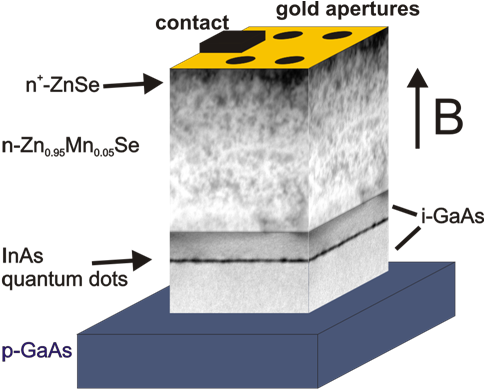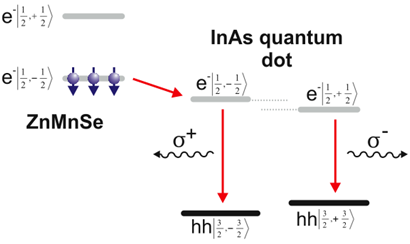A2.3: Spatially Resolved and Magneto-Optical Spectroscopy
Subproject Leader: Heinz Kalt and Michael Hetterich
Contributing Scientists:
Present: Pablo Asshoff, Andreas Merz, Daniel Rülke
Past: Wolfgang Löffler, Elena Tsitsishvili, Bruno Daniel, Jaime Lupaca-Schomber, Johannes Fallert, Kapil Chandra Agarwal
Spin Injection and Read Out in Quantum Dots
In subproject A2.3: Spatially Resolved and Magneto-Optical Spectroscopy, we advance a spin-based optoelectronic device utilizing spin states in InGaAs Quantum Dots (QD). We have demonstrated parallel electrical injection of electron spins into the QDs which are imbedded in the active region of a light-emitting diode (spin-LED) or transistor [1]. The so called circular polarization degree (CPD) is calculated from the luminescence intensities of the two possible polarizations of the emitted light and allows for direct analysis of the spin states in the QDs due to the selection rules [2]. Our collaboration has demonstrated single QD spin-LEDs with the highest spin injection efficiency worldwide proving that concurrent and repeatable initialization of spin-polarized electrons in several InGaAs QD with fidelity near unity is possible by electrical injection [3].
A Spintronic Single Photon Source
Based on the spin-LEDs developed in this project an electrically operated circularly polarized single photon source was designed. In quantum cryptography implementations, using the two circular polarization states of the emitted photons quantum states | 0 > and | 1 > could be represented, such that the device could be employed for securely coding and transmitting data. Such a device requires very high circular polarization degrees, as exhibited by the developed samples, and must emit single photons when voltage pulses are applied. The QD exhibits circular polarization degrees close to unity, and autocorrelation traces obtained with a Hanbury-Brown and Twiss setup prove the emitted photons to be antibunched [4]. This shows that the spin-LED acts as a source for single photons with the highest polarization degree obtained so far, indicating the preeminent efficiency of our approach.
Microwave Spin Manipulation
To enable spin-manipulation, we built up a setup for electron spin resonance (ESR) experiments. This setup allows for high field ESR (53 GHz) with a tunable high power microwave source. The samples are specially designed in order to fit into a cylindrical H01-resonator to achieve a well-defined microwave field distribution. Reduction of thickness and size allows for high Q-factors up to 1000 of the desired mode even for electrical contacted spin-LEDs loaded in the resonator.
Our setup also allows for optical detection of magnetic resonance (ODMR). First ODMR results show the resonance of the spins of the Mn2+ ions in the LED’s spin aligner (ZnMnSe) at 2.04 T. This resonant spin heating can be used to calibrate the microwave power in the spin-devices. Spin-relaxation measurements proof short lifetimes of the manganese spins in the order of some microseconds.
Future aim is the manipulation of single QDs via ESR experiments in the microwave cavity.
References
|
[1] |
M. Hetterich, W. Löffler, P. Aßhoff, T. Passow, D. Litvinov, D. Gerthsen, and H. Kalt, Advances in solid state physics, Vol. 48, R. Haug (Ed.), Springer, Berlin, Heidelberg, New York |
|
[2] |
W. Löffler, D. Tröndle, J. Fallert, H. Kalt, D. Litvinov, D. Gerthsen, J. Lupaca-Schomber, T. Passow, B. Daniel, J. Kvietkova, M. Grün, C. Klingshirn, and M. Hetterich, Appl. Phys. Lett. 88, 062105 (2006) |
|
[3] |
W. Löffler, M. Hetterich, C. Mauser, S. Li, T. Passow, and H. Kalt, Appl. Phys. Lett. 90, 232105 (2007) |
|
[4] |
P. Asshof, A.Merz, H.Kalt and M.Hetterich, Appl. Phys. Lett. 98, 112106 (2011) |
More information and other publications can be found at:
Institute of Applied Physics - research group of Professor Dr. Kalt
List of Publications 2006-2011 as PDF
Subproject Report 2006-2010 as PDF





